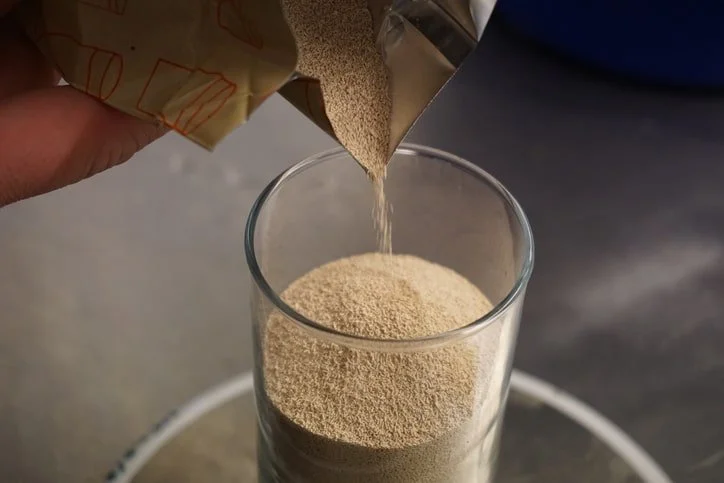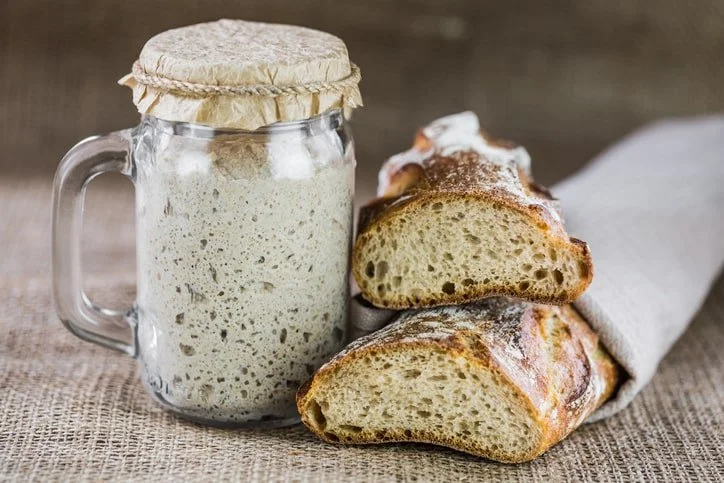A Basic Yeast Walk Through
Discover > Texas Home Cooking > A Basic Yeast Walk Through
What is Yeast
Yeasts are microscopic, eukaryotic, single-celled fungi that can survive in a wide variety of places including leaves, flowers, fruit, in soil, on the skin, even intestinal tracts of certain animals. There are over 1,500 species and 8,000 strains of yeast known to us that have been on earth for hundreds of millions of years. Some species are airborne and in part contribute to the rising of bread dough during proofing.
The name of the yeast species widely produced for baking and fermenting is Saccharomyces cerevisiae. This species has been instrumental in wine makings, brewing, and baking since ancient times. During the 19th century, bakers got the majority of their yeast from barm (yeast filled foam as a result of brewing ale). When many brewers switched to bottom-fermenting (as came the switch to S. pastorianus yeast) there was a shortage of yeast for many bakes. As a result, many methods (such as steaming bread or the Vienna process) sprung up in place of traditional yeast.
The work of Louis Pasteur (a French biologist and chemist) led to more advanced methods of culturing yeast. In 1879 the first specialized growing vats for the production of S. cerevisiae were introduced in Great Brittan. At the turn of the century, the US created its own methods for concentrating yeast in centrifuges leading to the invention and popularization of cake yeast.
Cake yeast must be refrigerated and had a shelf life of a couple of weeks. Naturally, this was inconvenient in times where refrigeration was unavailable (particularly in times of war). In world war II, Fleischmann's developed the first granulated yeast that could last for months on end without refrigeration. The granulated yeat also significantly reduced leavening time significantly cutting baking time. In 1970, Lesaffre created instant yeast (how long does instant yeast last?) which is most commonly used in home baking today.
How Does Yeast Work
Yeast is a fungus that feeds on inverted sugars and creates alcohol and carbon dioxide as a byproduct. In order for the yeast to be able to feed on complex sugars a naturally occurring enzyme called amylase must first break it down into invert sugars. Different processes take advantage of different aspects of this fermentation process.
Leavening
A leavener is a substance used in dough to make it rise. When the yeast feeds on the sugar and starches present in the dough they create carbon dioxide as a result making it rise. Yeast also conditions the gluten in the dough so it absorbs and holds these gasses more efficiently.
Fermenting
In the example of fermenting beer; wheat or barley (how long does barley last?) goes through a step called mashing. While the mash is made enzymes naturally present in the grain (amylase) convert starches to sugar that is easier for the yeast to breakdown. The yeast converts 1 mole of sugar into 2 moles of ethanol alcohol and two moles of carbon dioxide giving the beer its carbonation.
How Yeast is Cultured & Harvested
The yeast we use for any number of leavened baked goods starts off as something called cream yeast. Cream yeast is collected commercially in a large stainless steel tank on a number of forms of molasses-like sugar cane or beets. Commercially grown yeast is done so by providing ideal conditions to certain species of yeast cells. These cultures are fed and held at preferable temperatures promoting cells to grow and multiply. One yeast cell can multiply over 90 times per minute and grow up to 10 times its own size.
The first step in commercial yeast production is to collect the proper strain from a strain bank that is chilled to -112°F. The selected strain is then mixed into a culture medium and placed into an incubator to provide ideal temperature conditions. The culture is moved to larger tanks while being fed water, air, molasses (how long does molasses last?), and nutrients for more room to grow and multiply.
After a few days, the yeast is separated from the culture medium and passed through a centrifugal separator. The result is a light liquid called cream yeast. This yeast cream is stored at low temperatures to make sure the yeast cells stay are dormant. Cream yeast can be sold in individual packages or transported in large trucks to large bakeries.
Types of Yeast
Creamed yeast can be processed further by being fed through a vacuum filter which removes all the liquid and concentrates it into blocks known as cake yeast. This cake yeast can be stored unopened in the fridge for up to 3 months or in the pantry for 1-2 weeks.
Active-dry yeast is produced by further processing cake yeast. This is done by running the cake yeast through yet another rotary filter, then through an extruder, and finally a drying plant. By the end of the process, the yeast comes down to less than 5% moisture with a pantry shelf life of 3-4 months. Active-dry yeast has to be reactivated with warm water and optionally some sugar.
Instant yeast, also known as 'fast-rising' or 'fast-acting' yeast can shorten leavening time up to 50%. You can add this yeast straight to batters and dough without being activated in liquid first. Instant yeast has an unopened shelf life of around 2 years.
Brewers use 2 different strains of yeast depending on their method of brewing. Top-fermenting uses S. cerevisiae yeast while bottom-fermenting uses S. pastorianus. Top-fermenting yeasts are fermented at higher temperatures and are used to make ales, stouts, and wheat beers. Lagers are bottom-fermented. Brewers yeast is can be extracted from beer and used again anywhere from 5 to 10 times after which it gets processed into food flavoring, formulations for animal feed, and nutrition for culturing more yeast.
Nutritional Yeast (how long does nutritional yeast last?) is very often made from brewers yeast that has been used to the point of deactivation. Yeast is such a special supplement because it's one of the only natural ones that contain all 9 amino acids essential to humans. Nutritional yeast is also made independently but growing them in a large culture, deactivating them by heat, harvested, washed, dried, packaged, and sold. This yeast is often also fortified with extra nutrients.
Sourdough Starters
Sourdough starters are a form of homemade yeast culture. You can read and learn how to make a sourdough starter from scratch here. Starters are usually made by mixing equal parts flour (how long does flour last?) and water then leaving it in dark, warm conditions to grow. Flour naturally contains yeast and bacterial spores that can grow and thrive given the correct conditions. The naturally occurring enzyme amylase breaks the sugar down in the starter some that the wild yeast can feed and grow the colony of wild yeast and lactobacilli.




